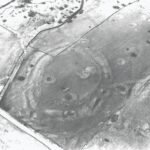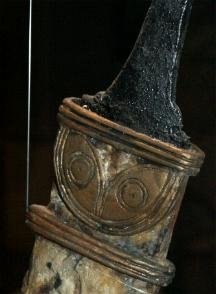Vitrification of Hill Forts
The Vitrification process
Vitrification as seen in hillforts is where the surface of the rampart has been heated to temperature that the stone has melted and bonded with its neighboring stone. In some cases forming a glassy surface.
The theoretical and limited practical attempts to recreate vitrification have largely been inconclusive, since significantly more effort was required to melt the rock than was expected. This has revealed several problems which our assumptions so far.
The use of imported sandstone to create the vitrified rock gives shows that the fort builder knew how to select rock specifically for its vitrification properties and shows that vitrified forts were definitely planned to be so, and therefore that other techniques will have been used to produce the desired effect. So far science has largely overlooked this and assumed more or less simple or un-planned fires causing vitrification.
The problem lies in concentrating the heat, simply having a very large fire close to an appropriate stone face will not easily vitrify the rock. For example when a fireplace is heated, the burning temperature of wood is at it´s highest from 800 to 1200 ºC, which should be hot enough to melt stone (1100 ºC) but according to studies carried out by Nunnanlahden Uuni Oy, the surface of hottest stones heats up to only 650 ºC in normal use. This shows the difficulty in getting a simple (but large) open fire to cause vitrification.
Some other points are worthy of mention. In the many cases of vitrification, it has been noticed that the rock applied to the rampart was of much smaller – stone fragments, it has been suggested that this was to increase the surface area of the vitrification rock and there increase the heat absorption. It also however indicated that an additional substance would have been required to hold these smaller fragments in place while they melt and adhere to the main body of the rampart.
Additionally, in some vitrified sites there is evidence that salt may have been used to increase the temperature of the fire, although this evidence is rare (France only) it may explain the largely coastal orientation of the Scottish forts.
Clearly if ancient man were prepared to go to such lengths in preparing the surface of the rampart ready for vitrification then other techniques would have been adopted which may have been overlooked in research assumptions to date.
In is our proposal therefore that in order to vitrify a fort, ancient man left nothing to chance. Having assessed the melting characteristics of the rock (with a test burn) and aquired additional more suitable facing rock if needed. The Rampart was prepared by the application of the surface stones, together with an additional flux-like compound which improved the adhesion and melting characteristics of the rock.
Once this was in place, the entire rampart was turned into an enormous kiln, by using clay to build a vented tunnel around the rampart, probably with multiple burning points and flues. This allows the heat to be amplified and directed towards the rampart, thus achieving the even vitrification that has been noted. Iron age kilns were more than capable of reaching the desired temperatures.
To date there is no evidence of the kiln technique being used, since it is likely that the clay kiln will have been designed to be fully removed such evidence is unlikely to be forthcoming. However we feel that this is the most likely method of creating a vitrified rampart since; It uses technology well known in the period; Once perfected, the technique would allow for the controlled even application of the effect which has been observed; It uses down to earth ordinary technology to provide the desired effect.
It is also likely that the preferred wood for the vitrification process would have been Oak and Yew, as these were readily available and have high burning temperatures
One other theory worthy of mention because of its historic interest rather than likely-hood is that the forts came under attack from “Greek Fire”.
Greek Fire
In ancient times there was a substance known through writings as Greek fire. This was some sort of ancient napalm bomb that was hurled by catapult and could not be put out. Some forms of Greek fire were even said to burn under water and were therefore used in naval battles. (The actual composition of Greek fire is unknown, but it must have contained chemicals such as phosphorus, pitch, sulphur or other flammable chemicals.)
“Greek Fire was the secret weapon of the Eastern Roman Emperors. It is said to have been invented by a Syrian Engineer, one Callinicus, a refugee from Maalbek, in the seventh century (673 AD). The “liquid fire” was hurled on to the ships of their enemies from siphons and burst into flames on contact. As it was reputed to be inextinguishable and burned even on water, it caused panic and dread. Its introduction into warfare of its time was comparable in its demoralizing influence to the introduction of nuclear weapons in our time. Both Arab and Greek sources agree that it surpassed all incendiary weapons in destruction. The secret behind the Greek fire was handed down from one emperor to the next for centuries. Rumors about its composition include such chemicals as liquid petroleum, naphtha, burning pitch, sulphur, resin, quicklime and bitumen, along with some other “secret ingredient”. The exact composition, however, remains unknown. For a thorough investigation of the weapon one can refer to Professor J.R. Partington’s book, “A history of the Greek Fire and Gunpowder”, Heffer, 1960. This volume quotes the ancient authorities extensively, with an excellent commentary. It also examines ancient and modern theories on the composition of the chemicals used in the Greek Fire. This is considered the most up to date source on the subject. “










